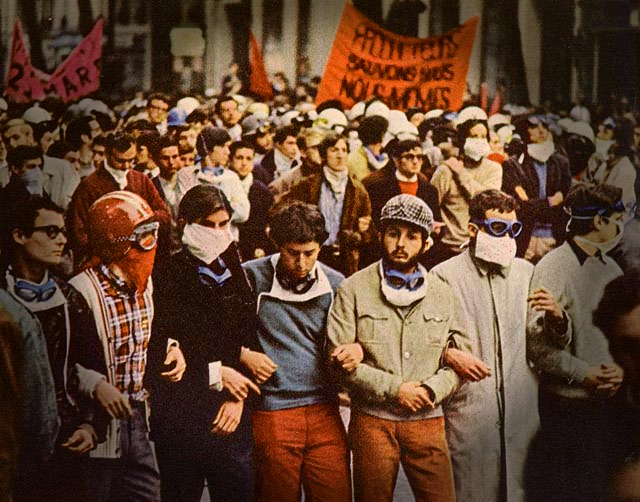
Review of May Made Me: An Oral History of the 1968 Uprising in France by Mitchell Abidor. AK Press, 2018.
By Sarah Miller, Philadelphia BRRN
From March through May 1968, as the world faced a global upheaval, France experienced a near revolution that is still a living memory. What began as an anti-Vietnam War protest eventually led to country-wide general strikes. But what was May 1968? Was it a revolution? A revolt? A natural part of the progression toward the social and sexual liberation of the late 1960s in Western Europe? Or was it nothing? It depends on who you ask. Fifty years after the events, author Mitchell Abidor sat down and listened to the stories of over twenty people who were there. He explores the emotional and political impact of May’s events, looks at both gains and losses, and asks the question: How did the events of May 1968 change France?
Rebellion in Post-War Prosperity
Many of the students describe their hope for a replay of the 1917 Russian Revolution or, at the very least, it’s prequel in 1905. They wanted a worker’s revolution and to fulfill the prophecy of their Marxist tomes. Abidor clearly illustrates that, although students had the desire to challenge the current capitalist system, they lacked the necessary strategy and organic connections to workers. Often insulated in the university groups students failed to engage the working class. It also turned out that the workers were not as revolutionary as the students had hoped. While the British workers were still dealing with rationing and unemployment, France recovered well from the war. The two decades of prosperity following World War II left the industrial working class of France with few complaints as their basic needs were met. The desperation and suffering was not there.
“May Made Me”
Despite this failing, the author points out the individual impact of the three months of revolutionary fervour. To paraphrase the title-inspiring participant, “I did not make May. May made me.” Reflecting back on May 1968, several people, particularly women, noted that they found their voice and continued to be politically active throughout their lives. Quiet young women raised in conservative, middle class society found themselves making impassioned impromptu speeches in student-occupied buildings while sons of wealthy families were barricading streets and confronting police. Compliant university students left their classes and exams to pull up the paving bricks that lined the streets of paris at the time and throw them at police. Of course, with the social connections of some participants and the threat of negative press, the police were given orders not to shoot. Given the scale of the three months of protest and barricades in the streets and occupation of universities and workplaces the death toll was surprisingly low.
Students took their growing fervor and reached out to the working class with the goal of expanding the rebellion. The workers were enthusiastic for the support but the trust was not there. There were unions but not radical unions despite the ambitions of the students. Up till that point the mainstream communist party in France, the PCF (Parti Communiste Francais), held a strong hegemony of support from workers and within the unions. However, PCF was more interested in reforms than revolution and Abidor describes their role as actively working to discourage a worker’s revolution or contact with the student radicals. The student radicals and farther left groups on the other hand had little in the way of a concrete alternative or working class base to push back against the counter-revolutionary machinations of the PCF.
Divergent Goals and Impact of May 1968
As word spread of the demonstrations in Paris people from across the country flooded the capital to join. Several participants spoke of the palpable cultural impact. Citizens who would normally pass each other in the streets were now stopping and talking to each other and beyond Paris, demonstrations and strikes grew though on a smaller scale. Again, Abidor focuses on the disparity between students and the workers and asks about the true impact of May 1968 on France as a whole.
Workers and students marched together but their goals were very different. Often union members were off-put by talk of politics. For them, it was more about small gains than sweeping change. When demands were met, it was time to go back to work. This is where the May rebellion lost its momentum. Yet society continued to evolve after the protests were over. Some say it was inevitable and others describe May 1968 as a catalyst for the women’s movement, gay rights and other social freedoms that came in the late 60s and early 70s. But all agree that capitalism came out of May 1968 unscathed. While the workers revolted, the bosses reorganized. Concessions are often made regarding individual freedoms as long as capital was not threatened.
May Made Me ends with no conclusion, no tying together of loose ends. The author ends with a few final interviews with anarchists who mostly played individual roles in the events. There were no formal anarchist groups to speak of during the demonstrations and marches and, in fact, few in the way of formal organizations. Abidor leaves the reader to draw their own verdicts on May, to listen to first hand stories and figure out the gains, the losses, the victories and the failures. Perhaps the most poignant insight from a May 1968 participant is that despite the categorizations, the societal imprint, the impact on the workers and French society in general, May was important simply because it happened. As one interviewee said, “You have to rebel, even if it failed.”
If you enjoyed this review we encourage you to read our other books and films reviews here, including “Land and Liberty: A Review of Anarchism in Latin America” and “Top 10 Films on Women Fighting Capitalism and Fascism.”
